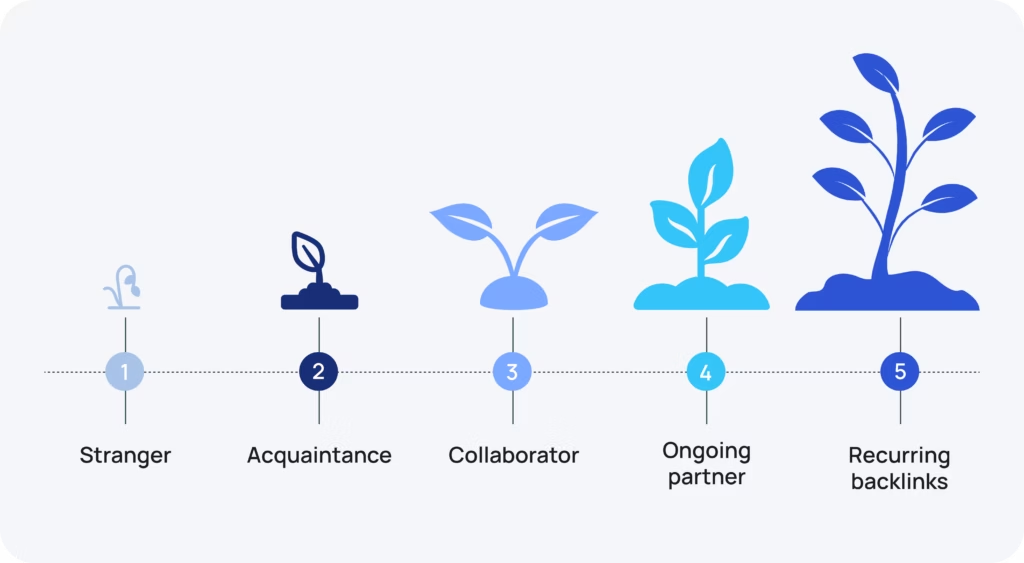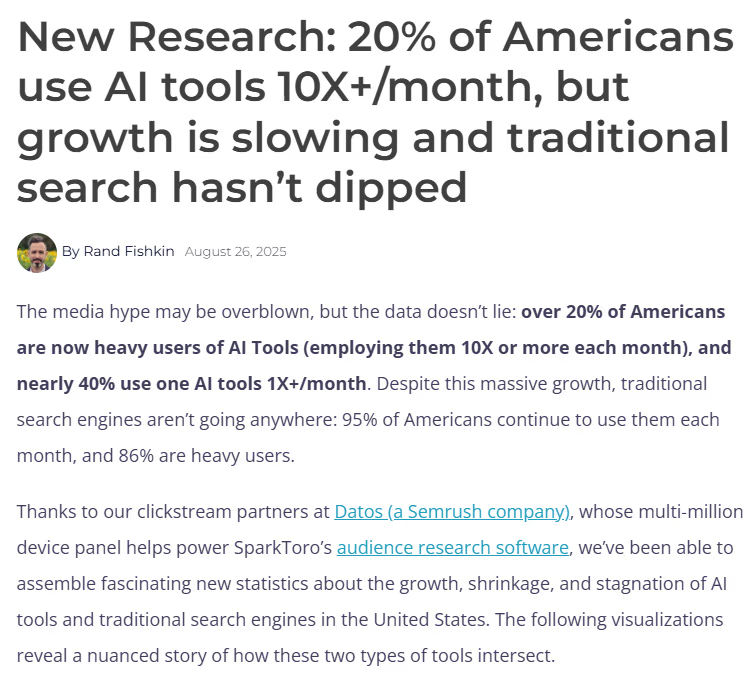You find a prospect website, track down the owner or the editor, and send them an email.
Silence.
Follow up. Crickets again.
Subsequent follow-ups? The same. You’re spending your resources and getting no results.
If this sounds familiar, relationship link-building can be the answer.
In the article, I will explain how this approach works, why it’s superior to cold outreach, and share examples.
You will also learn how to build long-lasting relationships and discover the mistakes to avoid.
What is Relationship-Based Link Building?
Relationship-based link building is an approach where you build genuine connections with publishers, editors, and other link builders that naturally help earn high-quality backlinks.
However, the link isn’t the primary objective. It’s a byproduct of the relationship.
As you gradually gain your partners’ trust, the links follow steadily.
This approach is more focused and less transactional than cold outreach.
Aaron Whittaker, the VP of Demand Generation at Thrive Internet Marketing Agency, compares it to nurturing a plant.
Cold outreach is like fishing with a wide net. … Relationship-based link-building is more like farming. Once something is planted and nurtured, it continues to produce over time.

Why Relationship Link Building Beats Cold Outreach?
SEOs agree that relationship link-building outperforms cold outreach.
For starters, it offers higher success rates.
5-10x higher.
While the cold email success rate rarely oscillates around 3-5%, warm pitching can fetch as much as 40-50%.
Pure cold to qualified editors ~3 to 6% reply rate, 0.5 to 1.5% link placement rate per 100 targeted emails. Warm (prior interaction or mutuals) 18 to 35% link placement on the first ask, rising to 30 to 45% over 90 days with useful follow-ups.
What makes it so much more effective?
Stella Morrison, the founder of The Stellastra Effect, says she doesn’t even open emails from people she doesn’t know because of the sheer volume of backlink requests.
And then, there’s an issue of trust.
Cold outreach is like knocking on a stranger’s door, while relationship-based link-building is more like chatting with a neighbor you already know,
The real kicker?
The benefits of building relationships with journalists, editors, and website owners compound over time.
They lead to more collaboration opportunities. And bring more backlinks.
We built a connection with a SaaS review site that first added us in a product roundup. Over time, that relationship grew into podcasts, case studies, and guest contributions that gave us backlinks across several of their sister sites.
And as the relationship is less transactional, your links are less likely to disappear within a few months.
However, it doesn’t mean cold outreach is completely useless as a link-building strategy, as Sharon Thind, of POLARIS SEO Agency, points out:
I believe that there is a time and place for the two types of outreaches that are commonly used. Relationship-based approaches create a higher-quality pipeline with better conversion rates and longer-term value, whilst cold outreach provides speed and scale when you need immediate results.
Types of Relationship-Based Link Building
Link-building relationships come in different shapes and forms.
Let’s go over a few common ones:
Research sharing and content collaboration
By contributing their proprietary data and expertise, organizations can collaborate on unique content assets that bring links organically, like the SparkToro and Datos’ reports.

One relationship we developed through a single guest article has grown into an ongoing contributor arrangement. That initial placement not only gave us a backlink but also opened the door to multiple bylines across different topics for the same publication.
Industry networking
Connecting with marketers in your niche via LinkedIn, joining Slack groups, like the one run by Hunter’s Antonio Gabric, or professional communities, like Superpath, often leads to collaboration and link-building opportunities.
One backlink turned into a Slack invite. That Slack channel led to three intros. Those intros brought in six more backlinks across different domains over the next year.
Podcasts & webinars
Relationships get you invited to podcasts or webinars, many of which link to your website in the episode notes.
The appearances also increase your visibility and cement your authority, leading to further opportunities.
For example, Tim Soulo of Ahrefs and Tom Niezgoda of Surfer have been collaborating for years now, and one of the fruits of their collaboration was Tom’s appearance on the Ahrefs Podcast. The episode has been viewed over 1,300 times.
Offline events
Event sponsorships, participation in talks, or local meetups often turn into backlinks. Apart from the link on the organizer’s website, the events may get covered in recap articles = more placements.

How to Build Digital Relationships
I’ve asked several SEOs, link-builders, and marketers for their advice on how to build relationships.
Danyon Togia, the founder of Expert SEO, recommends starting with the basics: making the effort to get to know them and simply being a nice person.
The best way to turn a cold contact into a warm, ongoing relationship isn’t a complicated tactic — it’s simply being a good person and building genuine rapport. Get to know them, ask about who they are, and engage beyond the immediate business objective.
Dirk Alshuth suggests engaging with prospective partners’ content on social media to establish the initial connection.
I try to show up in their world first, whether it’s commenting on LinkedIn posts, citing their work in our content, or inviting them to share their expertise with our audience. That way, the first “ask” doesn’t come out of nowhere.
Borja Obeso, the founder of Rebelgrowth & Marketing Director at TN Marketing, is a big believer in the value-first approach.
Give value first — offer a data point, template, or mini-tool their audience will actually use. Publicly credit them — cite their article in your post and send a short note with the exact paragraph and link. Make the first ask tiny … Close the loop — ship what you promised, share outcomes, then propose one relevant placement.
Finally, Paul DeMott, the CTO at Helium SEO, recommends building a dedicated CRM to stay on top of your link-building relationship.
We use a lot of custom CRM pipelines that we created in-house because standard outreach platforms give too much leeway to depersonalize. My system has a profile for each contact with information about the history of past conversations, interests, and preferred means of contact.
Common Mistakes in Relationship Link Building
What about the things you shouldn’t do? What are the gravest mistakes you can make?
For Danyon Togia, it’s making it all about a link.
One of the biggest mistakes I see is people trying to build a relationship solely for a link. It’s obvious, and the other person feels used. Real connections come from genuine interest.
Colleen Barry, Head of Marketing at Ketch, believes it’s chasing quick wins and asking for the link too soon:
I believe the biggest mistake is that they push too fast. Relationships don’t form overnight, and trying to rush the process can make you look insincere.
Do Link Building Agencies Actually Offer This?
Do link-building agencies favor relationship-driven strategies? Or do they resort to mass cold outreach?
Unfortunately, most agencies rely on cold outreach to secure links at scale. The result is that clients get lower-quality links that bring only short-lived success.
That’s why we’ve chosen the other path.
At our link building service, Editorial.Link, builds through long-term publisher relationships.
That’s how we manage to secure high-DR links (average DR67+) on relevant business websites with significant traffic.
Final Words
Relationship-based link-building requires “upfront investment,” but it’s more sustainable and future-proof than cold outreach.
If you’d like to work with a link-building agency with an extensive partner network that delivers high-quality backlinks, get in touch with the Editorial Link team!










